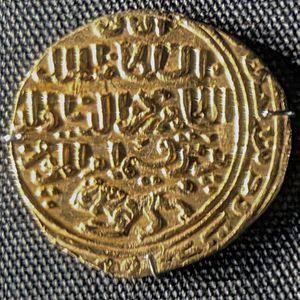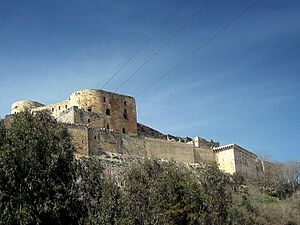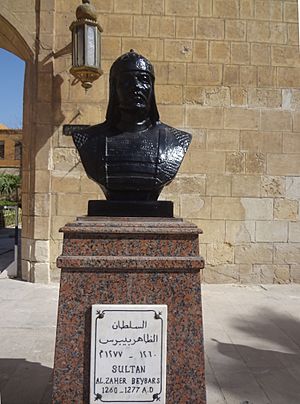Baybars facts for kids
Quick facts for kids Baybars |
|||||
|---|---|---|---|---|---|
| Sultan Misr wa-Suria Al-Malik al-Zahir Rukn al-Din |
|||||
 |
|||||
| Sultan of Egypt | |||||
| Reign | 24 October 1260 – 1 July 1277 | ||||
| Coronation | 1260 at Salihiyah | ||||
| Predecessor | Saif ad-Din Qutuz | ||||
| Successor | Al-Said Barakah | ||||
| Born | 19 July 1223 or 1228 Dasht-i Kipchak |
||||
| Died | 1 July 1277 (aged 50/55) Damascus, Mamluk Sultanate |
||||
| Spouse | Iltutmish Khatun | ||||
| Issue |
|
||||
|
|||||
| House | Zahiri | ||||
| Dynasty | Bahri | ||||
| Religion | Islam | ||||
Baybars (also spelled Baibars) was a powerful Mamluk ruler of Egypt and Syria. He was born in the Dasht-i Kipchak region, which is now part of Kazakhstan. Baybars was a skilled military leader. He played a key role in defeating the Seventh Crusade led by King Louis IX of France.
He also led the army that won the famous Battle of Ain Jalut in 1260. This battle was a major turning point. It was the first time the powerful Mongol army was truly defeated. Baybars' rule marked a time when the Mamluks became very strong in the Eastern Mediterranean. He helped end the presence of Crusaders in the Middle East. He also made Egypt and Syria a strong Muslim state. This state could defend itself from both Crusaders and Mongols.
Contents
Who was Baybars?
Baybars' full name was Al-Malik al-Zahir Rukn al-Din Baybars al-Bunduqdari. His name in his native Turkic language means "great panther" or "lord panther." He was also known as Abu al-Futuh. This nickname means "Father of Conquests." It refers to his many military victories.
What did Baybars look like?
People described Baybars as a tall man. He had olive skin and blue eyes. He had broad shoulders and slim legs. He also had a very powerful voice. It was noted that he had a cataract in one eye.
Baybars' symbol

Baybars used a panther as his special symbol, called a blazon. This was likely because of the meaning of his name. He put this panther symbol on his coins and buildings. For example, a bridge he built near the city of Lod shows a lion or panther playing with a rat. Some people think the rat might represent his Crusader enemies.
Baybars' Early Life
Baybars was born into the Barli tribe of the Kipchak people. This was in the Desht-i Kipchak region. When he was young, the Mongols invaded his homeland. Baybars was captured during this invasion. He was then sold into slavery.
He was first sold in the Sultanate of Rum. Later, he was sold again in Hama to a high-ranking Egyptian official. Eventually, the Sultan of Egypt, As-Salih Ayyub, took ownership of Baybars in 1247.
How Baybars Became Powerful
Baybars quickly rose through the ranks of the Mamluk army. Mamluks were soldier-slaves who became very powerful.
Fighting the Crusaders
In 1250, Baybars helped defeat the Seventh Crusade. This crusade was led by King Louis IX of France.
- At the Battle of Al Mansurah, Baybars used a clever plan. He let Crusader knights enter the town. Then, his forces trapped them inside. The Crusaders suffered heavy losses.
- The Battle of Fariskur followed. This battle ended the Seventh Crusade. King Louis IX was captured.
After these victories, there were changes in power. Baybars and other Mamluk soldiers were involved in the assassination of Sultan Turanshah. This led to Turanshah's stepmother, Shajar al-Durr, becoming the ruler.
Rising to Sultan
Later, Baybars had to leave Egypt due to political struggles. He returned in 1260. He became a commander under Sultan Qutuz. Together, they faced the Mongol army.
At the Battle of Ain Jalut in 1260, Baybars played a key role. The Mamluks decisively defeated the Mongols. This was a huge victory. After the battle, Sultan Qutuz was assassinated. It is believed Baybars was involved. He became the new Sultan of Egypt.
Baybars as Sultan
Once Baybars became Sultan, he quickly took control. He dealt with any challenges to his rule. He also made sure the Ayyubid rulers in Syria recognized him as Sultan.
The Caliph in Cairo
After the Mongols destroyed Baghdad in 1258, the Muslim world lost its caliph. A caliph was seen as a very important religious leader. In 1261, a relative of the last caliph came to Cairo. Baybars made him the new caliph. This helped Baybars gain more respect and power as a Muslim ruler. Even though these caliphs didn't have much real power, they added importance to Baybars' rule.
Fighting the Crusaders Again
As Sultan, Baybars spent his life fighting the Crusader kingdoms in Syria. He attacked them because they had sometimes helped the Mongols.
- In 1263, he attacked Acre, a Crusader capital. He then sacked Nazareth.
- He captured Arsuf in 1265. He promised the defending knights safe passage, but then enslaved them. He destroyed the castle.
- He also captured Haifa and Atlit, destroying their castles.
- In 1266, he besieged the fortress of Safed, held by the Templar knights. He promised them safe passage if they surrendered. However, he broke his promise and killed the entire Templar army. He then rebuilt and strengthened the fortress.
Campaigns in Armenia and Antioch
Baybars also invaded Cilician Armenia in 1266. This Christian kingdom had sided with the Mongols. Baybars defeated their forces and destroyed major cities like Mamistra and Tarsus. The Armenian king had to give up border fortresses to the Mamluks.
In 1268, Baybars besieged Antioch. This was a major Crusader city. He captured it on May 18. He had promised to spare the people. But he broke his promise and destroyed the city. Many people were killed or enslaved. This led to the fall of the Principality of Antioch.
He then captured Jaffa and later Ashkalon and Caesarea.
Talking with the Golden Horde Mongols
Baybars also used diplomacy. He wrote to the new leader of the Golden Horde Mongols, Mengu-Timur. He wanted to encourage them to fight another Mongol group, the Ilkhanate. Baybars kept friendly contact with the Golden Horde. This was partly because some of their leaders were Muslim.
More Crusader Campaigns
In 1271, Baybars besieged the strong castle of Krak des Chevaliers. This castle was held by the Hospitaller knights. He used powerful siege weapons. After capturing some outer defenses, he sent a letter to the knights. The letter seemed to be from their Grand Master, allowing them to surrender. The knights agreed. Baybars spared their lives. He then turned the castle's chapel into a mosque.
Later that year, Prince Edward of England arrived in Acre. He tried to ally with the Mongols against Baybars. Baybars made a truce with the Crusaders in Tripoli and with Edward. Edward was not able to capture any land from Baybars.
Campaign in Nubia
In 1272, Baybars invaded the Kingdom of Makuria in Nubia. This was a Christian kingdom. Its king had raided an Egyptian city. This led to many years of Mamluk involvement in Nubian affairs. By 1276, Baybars had conquered Nubia. The Nubians had to pay a special tax. They were allowed to keep their religion. Baybars also chose their new king, making Makuria a vassal state.
Fighting the Mongols Again
In 1277, Baybars invaded the Seljuq Sultanate of Rûm. This area was controlled by the Ilkhanate Mongols. He defeated a Mongol army at the Battle of Elbistan. He also captured the city of Kayseri. Baybars himself fought bravely in the battle. He said, "How can I be happy? Before I had thought that I and my servants would defeat the Mongols, but my left wing was beaten by them. Only Allah helped us."
Baybars decided to return to Syria. He was far from his supply lines. A new Mongol army might arrive.
Baybars' Death
Baybars died in Damascus on July 1, 1277. He was about 53 years old. Some people believe he died from drinking poisoned kumis (a fermented drink) that was meant for someone else. Other stories say he died from a wound or an illness. He was buried in the Az-Zahiriyah Library in Damascus.
Baybars' Family
Baybars had several wives. Some were daughters of important Mongol leaders. He had three sons: Al-Said Barakah, Solamish, and Khizir. He also had seven daughters, including Tidhkarbay Khatun.
Baybars' Impact
Baybars was the first Sultan of the Bahri Mamluk dynasty. He rose through the Mamluk army based on his skills. He took control after the assassination of Sultan Qutuz. Before becoming Sultan, he led Mamluk forces in the important Battle of Ain Jalut. This battle pushed the Mongols out of Syria.
In the Muslim world, Baybars is seen as a national hero. He is still admired in the Near East and Kazakhstan. However, Christians at the time disliked him for his successful campaigns against the Crusader States.
Baybars also helped bring many Mongols to Islam. He built strong relationships with the Mongols of the Golden Horde. Many Golden Horde Mongols traveled to Egypt and became Muslim.
Baybars' Legacy
Military Achievements
Baybars was a very popular ruler in the Muslim world. He defeated the Crusaders in three major campaigns. He also defeated the Mongols at the Battle of Ain Jalut. Many historians believe this battle was very important for world history. To support his army, Baybars built weapons factories and warships. He may have been one of the first to use explosive hand cannons in battle. His military campaigns also reached into Libya and Nubia.
Culture and Science
Baybars was also a good administrator. He built many important projects. He created a fast message system that could send messages from Cairo to Damascus in four days. He built bridges, irrigation systems, and improved harbors. He also built mosques.
He supported Islamic science. For example, he supported the medical research of his Arab physician, Ibn al-Nafis. Baybars also showed a special care for cats. He created a "cat garden" in Cairo. This place provided food and shelter for the city's cats.
His life story was written down in Sirat al-Zahir Baibars. This is a popular Arabic romance that tells about his battles and achievements. He is still seen as a hero in Kazakhstan, Egypt, Palestine, Lebanon, and Syria.
The Al-Madrassa al-Zahiriyya is a school built next to his tomb in Damascus. The Az-Zahiriyah Library still has many valuable old books today.
See also
 In Spanish: Baibars para niños
In Spanish: Baibars para niños
- Ablaq
- Bahri dynasty
- Cumania
- Cuman people
- Kipchak people
- Mosque of al-Zahir Baybars
- Sirat al-Zahir Baibars




